Przeniesienie twojej witryny WordPress do nowej domeny to duży krok, który wymaga starannego planowania. Zmiana nazwy twojej domeny może mieć wpływ na rankingi SEO, więc ważne jest, aby przeprowadzić ten proces ostrożnie.
Wielokrotnie z powodzeniem przechodziliśmy przez proces zmiany domeny, więc z pierwszej ręki znamy potencjalne pułapki i wiemy, jak ich uniknąć.
Chociaż tymczasowe wahania SEO są nieuniknione podczas migracji domeny, można zmniejszyć ich wpływ. Przy odpowiednim podejściu będziesz w stanie szybko odzyskać swój ruch i rankingi wyszukiwania.
W tym przewodniku przeprowadzimy Cię przez prawidłowy sposób przeniesienia WordPressa do nowej domeny bez utraty SEO.
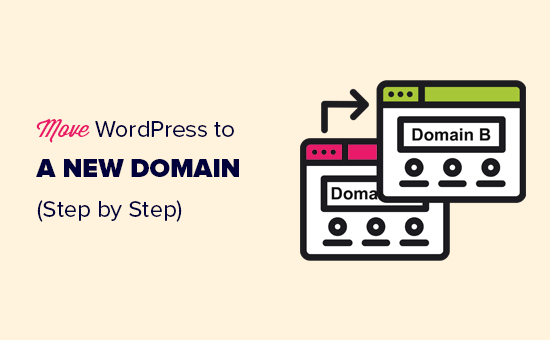
Migracja twojej witryny WordPress na nową nazwę domeny może być przerażająca, ale nie musi. Jesteśmy tutaj, aby przeprowadzić Cię przez każdy etap tego procesu.
Możesz kliknąć dowolny z poniższych odnośników, aby przejść do konkretnego kroku migracji twojej witryny WordPress do nowej nazwy domeny:
- What to Know Before You Change Domains
- Pre-Steps: What You Need to Get Started
- Step 1: Create a Duplicator Package of Your WordPress Site
- Step 2: Create a Database for Your New Domain Name
- Step 3: Unpack WordPress on Your New Domain Name
- Step 4: Set Up Permanent 301 Redirects
- Step 5: Notify Google About Your New Domain
- Notify Your Users About the New Domain Name
- Video Tutorial
Co należy wiedzieć przed zmianą domeny
Zanim zaczniesz, powinieneś wiedzieć kilka rzeczy.
Proces przenoszenia do nowej domeny będzie miał tymczasowy wpływ na twoje rankingi w wyszukiwarkach, ponieważ Google i inne wyszukiwarki będą musiały dostosować się do zmian.
Będzie to miało również tymczasowy wpływ na twój ruch z wyszukiwarek. Należy pamiętać, że jest to normalne i zdarza się wszystkim witrynom internetowym, które przechodzą na nową domenę.
Możesz jednak znacznie zmniejszyć wpływ na SEO, postępując zgodnie z tym przewodnikiem. Pokażemy ci właściwy sposób przenoszenia twojej witryny WordPress na nową nazwę domeny, konfigurowania odpowiednich przekierowań 301 i powiadamiania wyszukiwarek.
Należy pamiętać, że ten przewodnik nie dotyczy przenoszenia witryny WordPress na nowego hosta. Dotyczy on wyłącznie zmiany nazwy domeny. Chociaż proces jest podobny, istnieje kilka dodatkowych kroków. Te dodatkowe kroki pomogą ci zabezpieczyć twoje rankingi SEO i ruch.
Wreszcie, jeśli twoja stara witryna internetowa znajduje się na WordPress.com, musisz postępować zgodnie z instrukcjami w naszym przewodniku, jak przenieść się z WordPress.com na WordPress.org.
Kroki wstępne: Czego potrzebujesz, aby zacząć
W tym przewodniku zakładamy, że twoja witryna internetowa WordPress jest skonfigurowana na oldsite.com i próbujesz przenieść ją na newsite.com.
Zakładamy również, że posiadasz już konto hostingowe WordPress i jesteś zaznajomiony z panelem sterowania Twojego hostingu.
Będziesz także musiał wiedzieć, jak korzystać z klienta FTP, takiego jak FileZilla, lub jak edytować pliki za pomocą aplikacji Menedżer plików dostępnej w kokpicie twojego konta hostingowego.
Jeśli nie masz dostawcy hostingu lub chcesz zmienić dostawcę, zalecamy skorzystanie z Bluehost (świetny dla małych witryn + bezpłatna domena) oraz SiteGround lub WP Engine (świetne dla większych witryn lub sklepów internetowych).
Gdy masz już te rzeczy na miejscu, jesteś gotowy do rozpoczęcia procesu!
Krok 1: Utwórz pakiet Duplicator Twojej witryny WordPress
Pierwszą rzeczą, którą musisz zrobić, jest utworzenie pełnej kopii zapasowej twojej witryny WordPress.
Następnie użyjesz tej kopii zapasowej do utworzenia duplikatu twojej witryny internetowej, abyś mógł poprawnie skonfigurować przekierowania ze starej domeny do nowej.
Chociaż dostępnych jest wiele wtyczek do tworzenia kopii zapasowych WordPress, w tym poradniku będziemy używać Duplicatora.
Duplicator to najlepsza wtyczka do tworzenia kopii zapasowych i migracji WordPress. Używaliśmy jej do migracji niezliczonych witryn internetowych zarówno dla naszych własnych firm, jak i klientów. Przekonaliśmy się, że działa niezawodnie, nawet w przypadku bardzo dużych witryn internetowych.
Uwaga: Dostępna jest również bezpłatna wersja programu Duplicator, której można użyć do tej migracji. Zalecamy jednak uaktualnienie do płatnego planu, aby odblokować więcej funkcji, takich jak automatyczne tworzenie kopii zapasowych w chmurze, odzyskiwanie witryn internetowych jednym kliknięciem, łatwiejsze migracje i wiele innych.
Zacznijmy od zainstalowania i włączania wtyczki Duplicator na twojej starej domenie. Aby uzyskać więcej informacji, zobacz nasz przewodnik krok po kroku, jak zainstalować wtyczkę WordPress.
Po włączeniu wtyczka doda pozycję menu Duplicator w twoim panelu administracyjnym WordPress. Musisz przejść do strony Duplicator ” Kopie zapasowe, a następnie kliknąć przycisk “Utwórz nowy”, aby utworzyć nową kopię zapasową lub kopię twojej witryny WordPress.
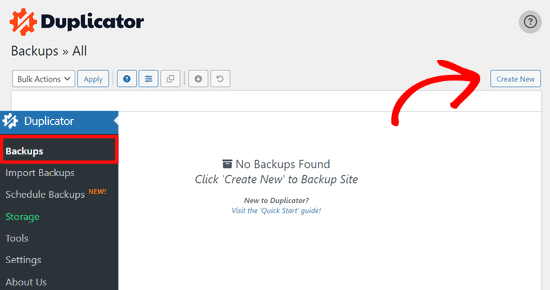
Duplicator zainicjuje teraz kreatora wstecznego i automatycznie przypisze nazwę do tego pakietu.
Kliknij przycisk “Dalej”, aby kontynuować.
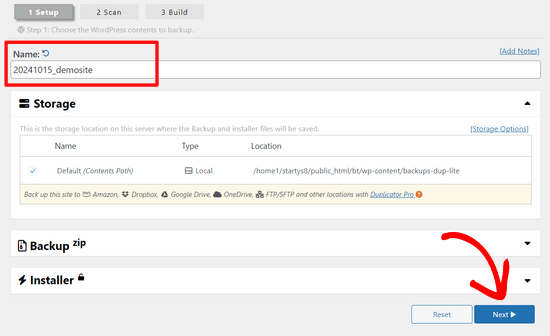
Duplicator przeprowadzi teraz kilka testów, aby sprawdzić, czy wszystko jest w porządku. Jeśli wtyczka znajdzie problem, pojawi się ostrzeżenie z instrukcjami.
Jeśli wszystkie elementy są oznaczone jako “Dobre”, kliknij przycisk “Utwórz”.
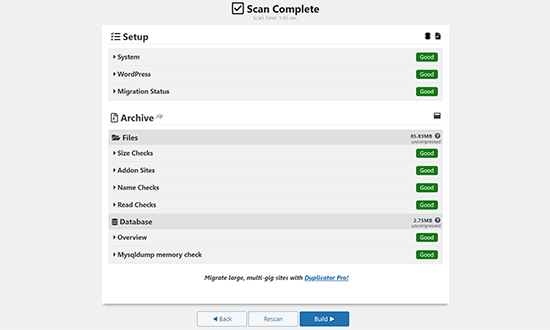
Wtyczka rozpocznie teraz tworzenie pakietu Duplicator plików twojej witryny internetowej. W zależności od rozmiaru twojej witryny, proces ten może potrwać kilka minut.
Po zakończeniu pojawi się opcja “Pobierz”. Kliknięcie jej spowoduje wyświetlenie opcji pobrania obu plików lub pobrania osobno instalatora i archiwum (zip).
Wybierz “Pobierz oba pliki”, aby pobrać je na swój komputer.
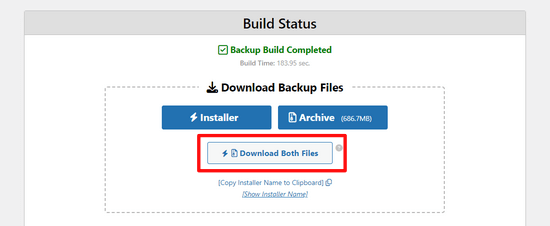
Plik archiwum to kompletna kopia twoich plików WordPress. Obejmuje on twoje motywy WordPress, ustawienia bezpośrednich odnośników, wtyczki, przesłane pliki i wszelkie inne pliki utworzone przez wtyczki WordPress.
Skrypt instalatora to plik PHP, który zautomatyzuje i uruchomi migrację WordPressa poprzez rozpakowanie pliku archiwum.
Krok 2: Utwórz bazę danych dla twojej nowej nazwy domeny
Przed przeniesieniem twojej witryny WordPress do nowej domeny, będziesz potrzebował nowej bazy danych SQL, aby rozpakować WordPress na nowej nazwie domeny.
Jeśli baza danych została już utworzona, można pominąć ten krok.
Aby utworzyć bazę danych, należy odwiedzić kokpit cPanel konta hostingowego, przewinąć w dół do sekcji “Bazy danych”, a następnie kliknąć ikonę“Bazy danych MySQL“.
Pokażemy, jak zlokalizować go na Bluehost, ale podstawowe instrukcje są takie same i powinny mieć zastosowanie do wszystkich dostawców hostingu.
Zaloguj się do kokpitu swojego konta Bluehost i kliknij przycisk “Ustawienia” pod swoją witryną internetową.
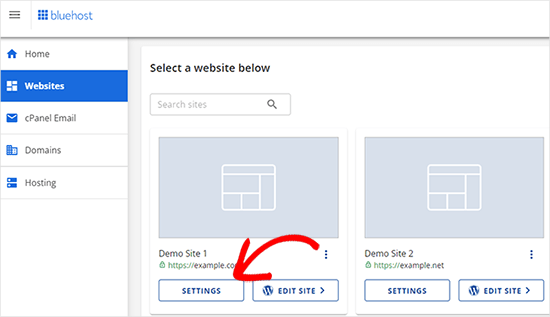
W ustawieniach twojej witryny musisz przejść do karty “Zaawansowane”.
Przewiń nieco w dół do sekcji cPanel i kliknij “Zarządzaj”.
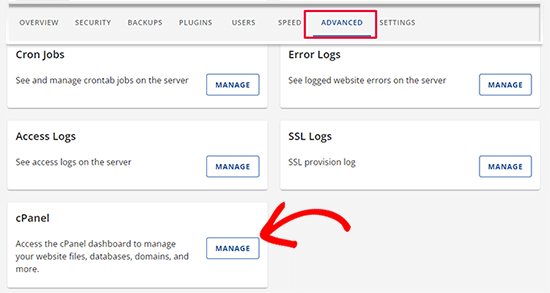
Spowoduje to otwarcie kokpitu cPanel.
Przewiń w dół do sekcji Bazy danych i kliknij opcję “Bazy danych MySQL”.
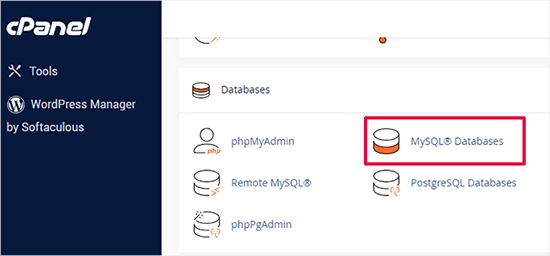
Uwaga: Twój panel sterowania hostingu może wyglądać nieco inaczej niż na zrzutach ekranu. Jednak nadal powinieneś być w stanie znaleźć sekcję Bazy danych z opcją tworzenia nowej bazy danych.
Wystarczy podać nazwę twojej bazy danych, a następnie kliknąć przycisk “Utwórz bazę danych”.
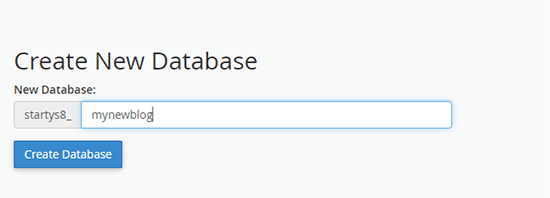
cPanel utworzy teraz nową bazę danych. Następnie należy przewinąć w dół do sekcji Użytkownicy MySQL.
Następnie podaj nazwę użytkownika i hasło dla twojego nowego użytkownika i kliknij przycisk “Utwórz użytkownika”. Pamiętaj, aby zanotować nazwę użytkownika i hasło w bezpiecznym miejscu.
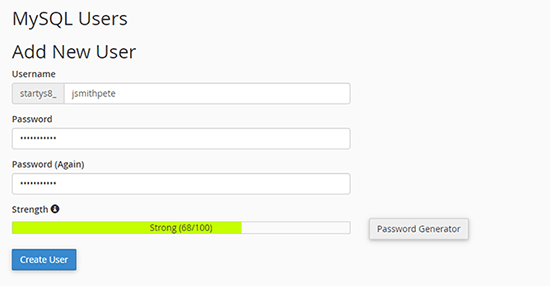
Nowy użytkownik, którego właśnie utworzyłeś, nadal nie ma uprawnień do pracy na bazie danych. Zmieńmy to.
Przewiń w dół do sekcji “Dodaj użytkownika do bazy danych”. Najpierw wybierz utworzonego użytkownika bazy danych z menu rozwijanego obok pola “Użytkownik”. Następnie wybierz utworzoną przed chwilą bazę danych i kliknij przycisk “Dodaj”.
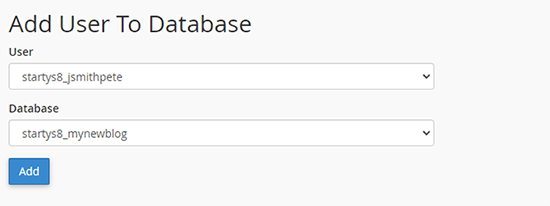
Następnie zostaniesz poproszony o wybranie uprawnień dla użytkownika.
Wybierz “Wszystkie uprawnienia” i kliknij przycisk “Wprowadź zmiany”, aby kontynuować.
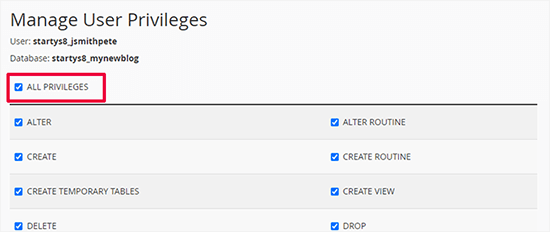
Twoja baza danych jest teraz gotowa i może być użyta do przeniesienia WordPressa na nową nazwę domeny.
Zanotuj nazwę bazy danych, nazwę użytkownika i hasło. Informacje te będą potrzebne w następnym kroku.
Krok 3: Rozpakuj WordPress na twoją nową nazwę domeny
Teraz musisz przesłać pobrane wcześniej pliki Duplicator do twojej nowej domeny.
Pakiet Duplicator obejmuje również twoją instalację WordPress. Oznacza to, że nie musisz instalować WordPressa na twojej nowej domenie.
Najpierw połącz się z twoją domeną za pomocą klienta FTP. Po połączeniu upewnij się, że katalog główny twojej witryny internetowej jest całkowicie pusty.
Następnie można przesłać archiwum i pliki instalatora do katalogu głównego. Zazwyczaj nazywa się on public_html.
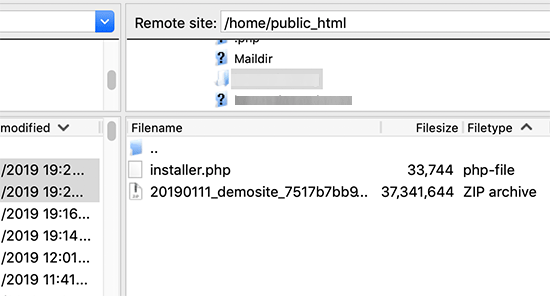
Po zakończeniu przesyłania obu plików możesz teraz rozpakować WordPress.
Otwórz nową kartę przeglądarki i przejdź pod następujący adres URL:
http://example.com/installer.php
Nie zapomnij zastąpić example.com twoją nową nazwą domeny. Spowoduje to uruchomienie kreatora migracji Duplicator.
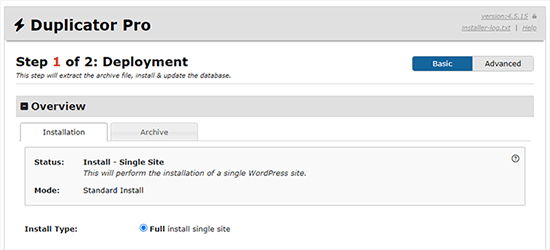
Instalator wyszuka plik archiwum, a następnie automatycznie wybierze opcje na ekranie.
Przewiń nieco w dół, aby wpisz informacje dotyczące bazy danych utworzonej w poprzednim kroku.
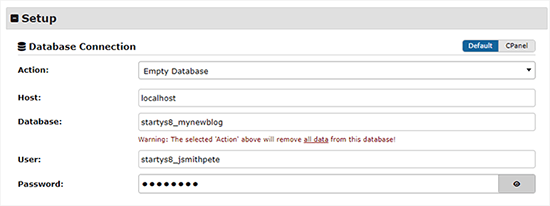
Następnie Duplicator automatycznie wyświetli adres URL twojej starej i nowej domeny.
Jeśli wszystko wygląda dobrze, kliknij przycisk “Zatwierdź”, aby kontynuować.
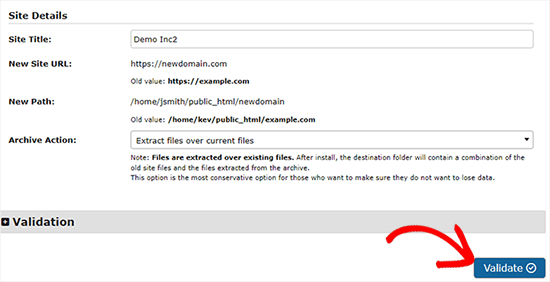
Duplicator podejmie teraz próbę połączenia się z bazą danych przy użyciu podanych informacji.
Po pomyślnym zakończeniu wyświetli się komunikat Validation Pass. W przeciwnym razie zostanie wyświetlone ostrzeżenie ze szczegółowymi informacjami na temat poprawki.
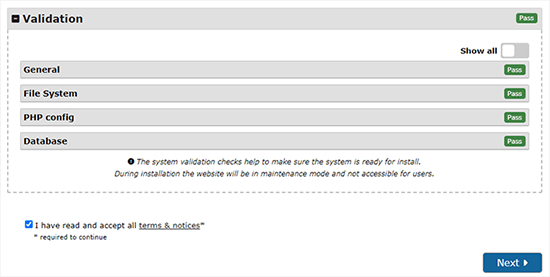
Kliknij przycisk “Dalej”, aby kontynuować.
Duplicator rozpocznie teraz importowanie twojej witryny internetowej WordPress. Po zakończeniu pojawi się komunikat o powodzeniu z przyciskiem logowania administratora.
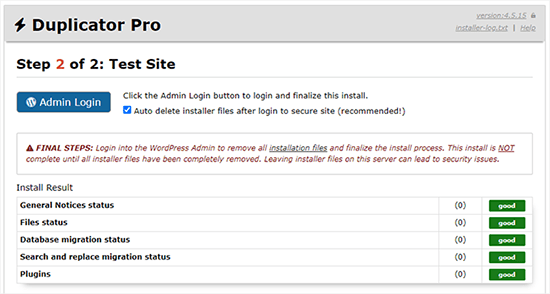
Duplicator automatycznie zaktualizuje adresy URL do twojej nowej nazwy domeny. Możesz teraz kliknąć przycisk “Admin Login”, aby wykonać kolejne kroki.
Krok 4: Ustaw trwałe przekierowania 301
Następnym krokiem jest skierowanie użytkowników odwiedzających twoją starą domenę na nową. Odbywa się to poprzez ustawienie przekierowań 301.
Przekierowania 301 są bardzo ważne dla SEO i doświadczenia użytkownika. Dodanie ich pozwoli na automatyczne przekierowanie użytkowników i wyszukiwarek na twoją nową nazwę domeny.
Innymi słowy, za każdym razem, gdy ktoś wyląduje na wpisie lub stronie w twojej starej domenie, zostanie automatycznie przekierowany do tego samego wpisu lub strony w nowej domenie, zamiast widzieć błąd 404.
Aby utrzymać przekierowania na miejscu, musisz włączyć starą instalację WordPress, aby mogła nadal przekierowywać do nowej, właśnie utworzonej.
Istnieją dwa sposoby konfiguracji przekierowań. Pierwsza metoda jest łatwa i wymaga zaledwie kilku kliknięć. Druga metoda wymaga ręcznej edycji plików.
Metoda 1: Skonfiguruj przekierowania 301 za pomocą All in One SEO
Do tej metody będziesz potrzebował All in One SEO (AIOSEO). Jest to najlepsza wtyczka WordPress SEO na rynku, która pozwala łatwo zoptymalizować twoją witrynę internetową WordPress pod kątem SEO.
Po pierwsze, musisz zainstalować i włączyć wtyczkę All in One SEO na twojej starej domenie. Aby uzyskać więcej informacji, zobacz nasz przewodnik krok po kroku, jak zainstalować wtyczkę WordPress.
Uwaga: Aby uzyskać dostęp do dodatku menedżera przekierowań, wymagana jest co najmniej wersja Pro wtyczki. Możesz również skonfigurować AIOSEO na twojej nowej witrynie WordPress, aby jeszcze bardziej zwiększyć rankingi wyszukiwarek i ruch.
Po włączaniu na twojej starej domenie, musisz przejść na stronę All in One SEO ” Redirects i kliknąć przycisk “Activate Redirects”.
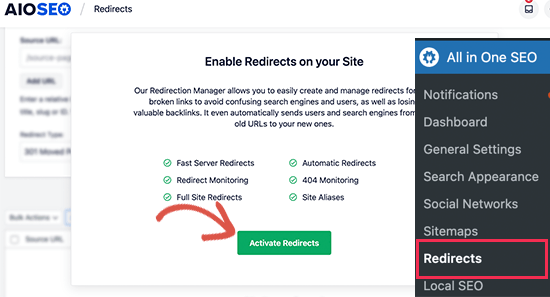
Następnie należy przejść do karty “Pełne przekierowanie witryny” i włączyć przełącznik “Przenieś witrynę”.
Następnie musisz wpisz twoją nową nazwę domeny obok opcji “Przenieś do domeny”.
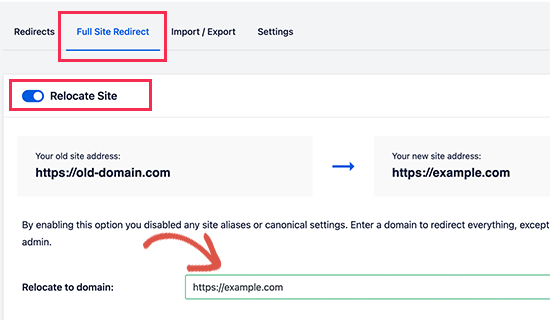
Nie zapomnij kliknąć przycisku “Zapisz zmiany”, aby zapisać twoje ustawienia.
Metoda 2: Ręczna konfiguracja przekierowań do nowej domeny
Ta metoda wymaga edycji pliku .htaccess WordPressa na twojej starej domenie.
Najpierw należy połączyć się z twoją starą witryną za pomocą FTP i edytować plik .htaccess.
Będzie on znajdował się w tym samym katalogu, co twój katalog wp-includes lub wp-admin. Otwórz plik .htaccess i wklej następujące linie kodu na samej górze:
1 2 3 | #Options +FollowSymLinksRewriteEngine onUnchanged: RewriteRule ^(.*)$ http://www.newsite.com/$1 [R=301,L] |
Upewnij się, że w powyższym kodzie zastąpiłeś newsite. com twoją nową domeną.
Po wprowadzeniu tych zmian przejdź na twoją starą domenę. Powinna ona automatycznie przekierować Cię do nowej domeny.
Jeśli tak się nie stanie, oznacza to, że przekierowanie nie jest skonfigurowane prawidłowo, a twój serwer prawdopodobnie nie obsługuje reguł przekierowań. Musisz skontaktować się z zespołem pomocy technicznej w twojej firmie hostingowej, aby włączyć RewriteEngine.
Krok 5: Powiadom Google o twojej nowej domenie
Teraz, gdy przeniosłeś WordPressa na nową nazwę domeny i skonfigurowałeś przekierowania, nadszedł czas, aby powiadomić Google o twojej zmianie adresu. Pomoże to Google szybko znaleźć twoją nową domenę witrynową i zacząć wyświetlać ją w wynikach wyszukiwania.
Po pierwsze, musisz upewnić się, że zarówno twoja nowa, jak i stara domena zostały utworzone w Google Search Console jako dwie różne właściwości. Instrukcje znajdują się w kroku 1 naszego przewodnika po Google Search Console.
Następnie należy wybrać starą nazwę domeny jako włączoną właściwość w kokpicie Twojego konta Google Search Console.
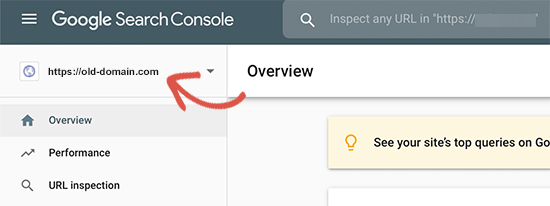
Następnie kliknij menu Ustawienia w lewej kolumnie.
Teraz możesz kliknąć narzędzie “Zmiana adresu”.
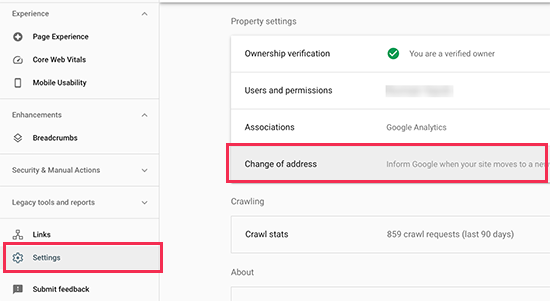
Teraz musisz wybrać twoją nową domenę z sekcji Aktualizuj Google.
Następnie należy kliknąć przycisk “Zatwierdź i zaktualizuj”.
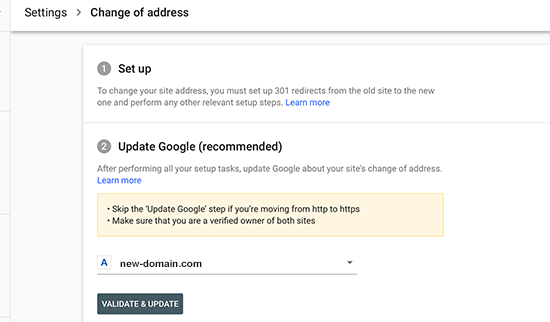
To wszystko. Google potwierdzi teraz, że twoja stara domena przekierowuje do nowej domeny i zapisze zmiany.
Na następnym ekranie Google Search Console wyświetli kreator krok po kroku, aby przesłać twój wniosek o zmianę adresu.
Powiadom swoich użytkowników o nowej nazwie domeny
Podczas gdy przekierowania 301 wykonują swoją pracę, zawsze dobrze jest publicznie ogłosić migrację.
Możesz to zrobić po prostu pisząc wpis na blogu o twojej nowej witrynie i udostępniając go na swoich kontach w mediach społecznościowych.
Jeśli posiadasz subskrybentów newslettera e-mail lub powiadomień push, to do nich również powinieneś wysłać ogłoszenie.
Może to być pomocne na wiele sposobów.
Przede wszystkim, twoi użytkownicy z większym prawdopodobieństwem zapamiętają nową domenę, gdy już o niej przeczytają.
Po drugie, możesz poprosić swoich użytkowników, aby dali ci znać, jeśli zauważą jakieś błędy. Sam nie jesteś w stanie przetestować swojej witryny w każdym rodzaju przeglądarki lub środowiska systemowego, więc zawsze pomocne jest spojrzenie na nią świeżym okiem.
Film instruktażowy
Zasoby bonusowe
Poniższe artykuły i poradniki pomogą ci śledzić i odzyskać twoje rankingi SEO po migracji do nowej nazwy domeny:
- Najlepsza lista kontrolna migracji WordPress SEO (dla początkujących)
- Jak sprawdzić, czy twoje wpisy na blogu WordPress są pozycjonowane dla odpowiednich słów kluczowych?
- Jak śledzić odwiedzających twoją witrynę internetową WordPress?
- Wskazówki dotyczące optymalizacji twoich wpisów na blogu pod kątem SEO (lista kontrolna)
Mamy nadzieję, że ten poradnik pomógł ci przenieść twoją witrynę WordPress na nową nazwę domeny. Możesz również zapoznać się z naszym przewodnikiem na temat tego , jak uzyskać bezpłatną domenę e-mail lub postępować zgodnie z instrukcjami w naszym kompletnym przewodniku SEO WordPress.
If you liked this article, then please subscribe to our YouTube Channel for WordPress video tutorials. You can also find us on Twitter and Facebook.





WPBeginner Staff
We are not sure about this option, we haven’t tried it ourselves so we can not recommend it. Any redirection you set up needs to be 301 so that search engines can update the new location.
vikramforever
I have my domain with godaddy and they have redirect option with match path mentioned on their help page – http://support.godaddy.com/help/article/5120/redirect-urls-with-your-hosting-account.
Is this a feasible option when i transfer my active site to another domain? As per the option in the post, i need to maintain the hosting for my old domain till the time i want the redirects to work. Using redirect with the ‘match path’ option will do away the need to do so. But i want to be sure that this is an option which works the same way the script (as you mentioned) works.
Keely Worth
Excellent – makes the process of moving a WordPress site a breeze. Thanks.
Ayman
I’ve just migrate a website site from one URL to another. I would really like to thank you for this great post. 100% working and a very simple instructions
Anas Khan
Nice post. I have few questions too,
I have 2 blog on WordPress. The new blog is active and i have 45 posts in my new blog. The old blog has 192 posts and all posts are index on google.
Now i want to transfer and publish all old 192 posts to my new blog so all posts can me view on my new blog. If i trash all posts from my old blog, remove the sitemap and webmaster tool of old blog and after 30 days i publish old posts to new blog using Add new post button then it works ? Is it considered a duplicate content ?
WPBeginner Support
You can simply import those posts to your new blog and set up a 301 redirection on your old posts on a post by post basis.
Admin
Mohammed Saimon
Yes its a nice post. Thanks to the author.
Vinish Garg
This is an excellent post and gave me some new direction for moving my WP blog from one domain to another. I will appreciate if you can correct me if I am wrong in planning it as below.
– I know hostgator and I understand how to use File Manager and setup WP, database and import/export database (xml files)
– My current WP blog is at: http;//www.example.com, and I want to move it to another domain http://www.example.org.
– One, I will setup new WP at new domain’s root (database, config file, custom theme, and import data file from old site)
– The new site will show the site exactly like old site, BUT only difference is the URL (because of new domain).
If everything is correct this far… I am not sure how to use redirects for all my old domain’s pages/posts to new domain. Can you please advise?
WPBeginner Support
You can do that by following the step 3 of this guide, setting up 301 redirects.
Admin
Stefan
Great post, unfortunately I have read it too late and have already moved my domain. All I have done is I have purchased a new domain for my blog (, before it was it’s still active for another 2 months). I have changed the WordPress URL and Site Address in wordpress general settings and resubmitted the sitemap with the new URL. That’s all I have done.
This was one month ago and since then the traffic is now totally down, from more than 1,000 pageviews a day to now not even 200.
If I google search “thailand redcat” not even one of my pages shows up. The sitemap however has successfully been submitted:
2:51:35pmStefan
Do you know what could be the reason for this and how can I solve the problem and get the search results and eventually traffic back to normal again?
Any help would greatly be appreciated. Cheers!
WPBeginner Support
Stefan, we are not sure we understand the process you followed to move your site to a new domain. Here are some general tips. First make sure search bots are able to crawl and index your site? Check your site in Google webmaster tools for crawl errors.
Admin
Charlie
I have the same problem. Google crawlers find a 500 error on the whole site since is did the migration. I tried on 2 different environments/providers, different php versions, I tried to deactivate/reactivate all my plugins one by one, I tried to regenerate the permalinks, the htaccess, the robots.txt… nothing works.
Mr Joy
Thank you for your great post. I followed your post and moved my site to new domain. It’s all working fine but there is only one problem in my site regarding WordPress visual editor. The problem is “When I upload an Image on any post by Add Media option, then click on the picture thumble “edit image” an iFrame come with a Not Found Error. But when click delete it works fine. Please help me to resolve the problem. Check the screenshot : http://bit.ly/1fqjE1b
WPBeginner Support
The first thing you can try is to update your permalinks, simply go to Settings » Permalinks and click on the save changes button.
Admin
AP
Excellent work – thanks very much! It might be helpful to add the reply above – the one dealing with new database creation and use – to the initial instructions, as not everyone will read the comments before attempting a transfer.
Gary Kirwan
Great article. My question is I use the affiliate cloaking method recommended by Yoast, which means I have a .htaccess file under a folder called /out/
Would I need to add the same 301 redirect code mentioned in the article to both .htaccess files in the root directory and affiliate links sub-folder? Does adding the 301 redirect code to the root directory .htaccess file only automatically cover the sub-folders one?
My goal is to make sure that external affiliate links work correctly as well.
Kingsley
Great tutorial, will be using it to Migrate http://www.ideacrunch.org to http://technblogging.com in the next few days but i have a question to ask. The database password and username name will it be the same as the old site?
Craig
Hi, appreciate this is a little late. But i literally just want to move from http://www.unlockworldtv.co.uk to http://www.unlockworldtv.com is this tutorial suitable for that? I am not moving hosts, just changing the url
WPBeginner Support
Yes it is.
Admin
Craig
Thanks. I’m stuck at the go to newsite.com/installer.php I just get my old site but with 404. I didn’t install wp in the new directory, just created an empty directory to put the installer and zip in. I am pointing my new domain from the registrar account to that new directory with my web host but not getting anything but the theme and 404. Any obvious tips?
Craig
just FYI i resolved this. It appears to be an issue with 1&1 (no surprise) but can be resolved by having an index.html file present. So for anyone on 1&1 adjust step 2 from
“Make sure that the root directory, or the directory where you want to copy your website is completely empty.” to “Make sure that the root directory, or the directory where you want to copy your website is completely empty except for installer.php, the .zip file AND an index.html page”
I believe this is to do with the way 1&1 prioritise pages on their server.
Denis Fitzgerald
Hi – Thanks for the article. I have a question: I am switching my site from Tumblr to WordPress. It has its own domain. I would like to know if the buttons at the end of each article showing social shares, Twitter, Facebook, Google+, will maintain the original share count or go back to zero. Thank you.
WPBeginner Support
If its the same domain and your URL structure remains intact, then hopefully you will be able to retain those social counts.
Admin
Bertjan
Excellent guide! Thank you very much.
Sudha Mathew
Hi, I moved my site using redirects about 6 months ago and it works fine. I need to renew my contract with web security company soon. So I need to know how much traffic is still getting redirected from the old site. Could you explain how to do that? I am not tech savvy but can use both Webmaster tools and Google Analytics.Thanks in advance!
Best
Sudha
Moti
Hello,
I would like to change the domain name of my site (staying on the same host).
In the instructions above it is indicated that I should “make sure that the root directory, or the directory where you want to copy your website is completely empty.”.
In my case the WP is installed in the root directory (I have the wp-content folder under public-html) – I assume that this means that my WP is installed under the root directory.
Which folders should I clean / delete before I run the installed file generated by the duplicator ?
Thanks,
Moti.
Declan
Thank you for the tutorial. Worked great with no problems whatsoever.
I do, of course, have a question regarding SEO.
My old site wasn’t registered in Google webmaster tools, so obviously there’s no option to let them know about the changes I’ve made. My question is: Will I need to register my old domain with Google webmaster tools first, and then my second domain…and then notify them abut the changes?
Any thoughts would be great.
Thanks again for the article, it was extremely helpful.
Declan.
WPBeginner Support
Yes, you will have to notify about the change on your old site’s webmaster tools account. However, this is just the fastest way to do it. If you have setup your 302 redirects then search engines would pick that up as well.
Admin
reza
hi,
this works just great, i redirect my old.com which is my main domain to new.com which is an addon domain (in the same hosting)
but when i added another new addon domain, it makes my new addon domain can’t be accessed….it always redirect my addon.com to new.com/addon.com…
can you help ??
Jennifer @ Delicieux
Thank you for explaining this in so much detail. I have a question though. I’ve been thinking about moving to a new domain name for some time, but I wanted to know if I would have any issues given the fact that earlier in the year I changed the permalink structure on my old blog.
I followed the instructions on Yoast on how to change my permalink structure and edited my .htaccess file, and wonder if this will cause problems when I move to a new domain? This is the one thing that is holding me back because I don’t want things to screw up and lose rank and end up with broken links.
WPBeginner Support
you can transfer your old .htaccess file to your new site. If the .htaccess file has any references to the old domain name then replace those with the new domain name and your would be OK.
Admin
Hrayr
Hey,
First of all many thanks for this article – it worked great without any problem for me!
I have one simple question specific to my case, would highly appreciate your thoughts on this.
Basically i used this approach to copy my wordpress site from localhost to the host/domain from 3rd party.
As said all worked ok – i just want to make sure that this approach doesn’t leave any old urls/links/references that can “annoy” google to crawl this new site. My site is pretty basic, so in worst case scenario i can just recreate if there is any disadvantage of crawling/SEO when site is copied by duplicator.
Is there any known SEO issue of new site that you are aware of?
WPBeginner Support
We not aware of any SEO issues, but if you come across any you can inform the plugin author by opening a support thread on plugin’s page.
Admin
Kevin
I don’t think the way you suggest users do their 301 redirect is the best way. It’s well documented, even recommended by Google, that you do page-to-page redirects, NOT dump all your old website’s pages to the homepage of the new site. The htaccess code you provide does the latter. It isn’t a good way to preserve link juice.
Maybe you can refer us to a good htaccess tutorial instead? There are also online htaccess generators out there that can make it much faster to do page-to-page redirects.
WPBeginner Support
Kevin, you are right and rewrite rules in the article do exactly that. Instead of redirecting users to the homepage it sends them to the individual page. $1 at the end of code appends the link with the proper permalink structure.
Admin
Julian
Hi, when I’m doing this after ‘deploy’ it misses the ‘update’ section and reverts back to a 404 page at the old web address… any idea what could be causing this?
Many thanks!
Munna
Thank you very much for this post. I was in trouble redirecting my oldsite visitors to the new site. But your .htaccess code made it super easy because both sites were in the same hosting server.
Raspal
Hello,
I completed all the steps and the blog at the new site is up fine. But I can’t login to the admin area. I have two users, one is an admin user. I get this error when trying to login:
“ERROR: Cookies are blocked or not supported by your browser. You must enable cookies to use WordPress.”
I tried different browsers and also tried clearing any cookies. Also tried changing password. Password was changed fine but still getting the above error.
Can you please help ASAP?
Using WP version 3.7.1
Regards,
Raspal
Neil Bargas
Thanks man! 100% working and a very simple instructions.
Lynn
Fantastic article! You are my hero of the day.
Jahid
”Login to your new site’s WordPress admin using the same username and password that you had on the old site. Go to Settings » Permalinks in your new site’s WordPress admin and click on the save button.”
Once I login, it shows me the first step page ”Step 1: Files & Database” instead of showing the WP dashboard. Help!
WPBeginner Support
Seems like you need to update your wp-config.php file
Admin
Chrissy
Hi! Thanks so much for this helpful article – I’m in the process of running through the steps now.
My one question is:
I have my blog hosted at one domain, let’s call it http://www.reallylongdomainname.com/blog, but I have a redirect to forward it to my other domain: blog.shortername.com. I now want to migrate the blog to shortername.com/blog, because some of the links don’t work after the redirect.
All my posts and things already have permalinks at shortname.com/blog/post#, so do I really need to do any of this 301 stuff? Am I safe to skip steps 3, 4 & 5, or is there something I need to consider? And will I need to delete the old blog or just the redirect once I launch it at the new domain?
Would be really great to find out how to proceed, since I’ve tried dozens of things this week and no situation is quite the same as mine :/ Thanks!
WPBeginner Support
The purpose of 301 redirects is to not just redirect users but also let search engines know that you have moved to the new location so step 3 and 4 are a must otherwise it may affect your SEO rankings.
Admin
Mark P
Great post. One question though.
Let’s say someone clicks on a backlink for my website’s old domain. (Let’s call it olddomain dot com / blogpost1). Will this then redirect to the new domain’s respective link (newdomain dot com / blogpost1) instead of just redirecting to the new domain’s homepage?
WPBeginner Support
Yes, it would redirect users landing on your posts and pages on the old site to the posts/pages on the new site.
Admin
Mark P
Thank you!
Morgan
Question: I am switching my site from one host to a new host. At the same time, I am changing my domain name. I have already successfully transferred my WordPress site to my new host using the new domain name. I now am to step 3 and want to use 301 redirects to point those old URLs to the new site URLs. However, the old site is on the old host and I’m planning on getting rid of that site.
Will the 301 redirects still work? Or do I also need to move the old site over to my new host and THEN do the redirects? I’m a bit unsure what to do and would love any advice.
WPBeginner Support
If it is possible for you to keep the old site online for at least a month, then you can add 301 redirect. After that update your site’s information on Google Webmaster tools. Once you have recovered your search rankings and traffic you can then close your account with the old web host.
Admin
Nj
Thank you for the helpful posts, but sometimes with such plugins, a video will help A LOT. I hope you will consider this
Thanks again
Arnold
Hi. Could you please elaborate the part where you said “The installer will ask you to provide database information for the new site and check the box for Table removal?” Where do I find this database information? So should I check the box for Table removal? Thanks!
WPBeginner Support
This is the database where you will be importing your old site from the package you created earlier. Log into your web hosting dashboard, find phpmyadmin and create a new database. Come back to installer.php and provide the new database name, host, user and password.
Admin
Kara Lumsden
So you should not install wordpress on the root of the new domain? The only thing you need to do on the new domain is only create a new database, is that correct? Can you elaborate a little more on how to create the database in phpmyadmin?
So appreciative, thank you for all that you do!
WPBeginner Support
No it is OK to install WordPress on the root of the new domain. Yes, you just need to create a new database and the Duplicator takes care of the rest.
Kara Lumsden
Can you please provide instructions on how to create the database?
Thank you very much,
Kara
Dennis J. Smith
How long should one wait before deleting the old site?
WPBeginner Support
30 to 90 days, depends on how successful your move was. If you are confident that your new domain has gained nearly the same traffic as the old site, then you can delete it.
Admin
dyer
Hi ive encountered an issue. Im unable to save my Permalinks as I cant locate the WP admin file ive tried to upload the WP admin file again but this hasn’t the issue please could you advise me if there is any other steps I can take to rectify this issue.
Thanks
Dyer
WPBeginner Support
@dyer We are unable to understand your question. We are assuming that you can not access your WordPress Admin area. In that case, connect to your site using an FTP client like filezilla. Find the file
.htaccessdownload it to your hard disk and delete it from your website. Hope this resolves your issue.Admin
Fakhre
Thanks for the article guys!
I am hosting my site on Bluehost and just want to change the Domain name without loosing the SEO and backlinks.
My site contents is huge, i have about 8000 posts. Any solution for renaming the domain??
Sanjay Patel
Hello…
Really useful information but duplicator plugin is not working in my website. please solve my problem. how to do this?
Thanks in advance.
Dinah
Does this work with moving from one domain to a subdomain?
Editorial Staff
Yes
Admin
Dinah
Does this work for moving to a new subdomain? Like if my wordpress blog was on oldsite.com and I wanted it on blog.newsite.com, would I do the same thing?
Editorial Staff
Yes.
Admin
Emmie
I recently did this and the links and all redirected fine and dandy, however I just got slapped by Google with a penalty for instantly having so many backlinks – they think I bought them. Has anyone else encountered this? I made the appropriate notifications in Google Webmaster tools before moving, and it’s done nothing to help this. It’s hit me hard, so if anyone has experience in remedying this, please share!
Editorial Staff
Hey Emmie, where do you see that you get slapped for having too many backlinks? Does it show you that error in your Webmaster Tools? Just trying to see how did you come to the conclusion that you got penalized by google.
https://www.google.com/webmasters/tools/reconsideration << This is the page where you can send a reconsideration request to Google.
Admin
Lateef Adewale
Do you have any idea if this will work if i am moving a site from Bluehost to Wp Engine.
Editorial Staff
Yes it should work.
Admin
Emily
Just went through this whole process, worked perfectly and just what I needed to know. Thank you WPBeginner! The only glitch I ran into was my own fault – didn’t deactivate my security plugins first so I had to do it all over. Now, I am an expert… : )
Sandra Christie
Thanks for the article!
Are the steps for moving the same domain to a new host basically the same? And can that cause a drop in SEO as well?
Travis Pflanz
As well, the “Change of Address” option in Webmaster Tools is now in the Options menu at the top right in in Gear icon.
Zach Smith
Thanks for publishing another great article for us. This is best for any technology related blog.
Bob
Thanks–this is great information. I’m really excited to learn about Duplicator. While moving a domain is something I might have to do occasionally, I’m constantly cloning environments for development and testing purposes. The manual cloning process I’ve been using is time-consuming and potentially error-prone. Duplicator has the potentially to be a considerable improvement!
Sam
I just moved WP to a new domain and server using this method. Webmaster Tools now shows many 403 errors on the new server for each folder in uploads such as wp-content/uploads/2012/07 and one 403 error for each of the months. On my old server I did not get this. When moving the site should we also change or check the permissions? What should they be for the wp-content/uploads folder?
Editorial Staff
Google should not be indexing the folders rather they should be indexing the files inside of it. If you try to access the folder directly using a browser, WordPress will give you a 404 error. You don’t want to allow access to a directory that has no index page, which will then produce a directory listing that will get indexed and crawled, including the links to all files.
Admin
sam
Thanks for the reply. Then why does Google show a 403 error for the folders in webmaster tools. Does this not mean that something is wrong?
Zimbrul
THIS IS THE ARTICLE I WAS LOOKING FOR 1 YEAR NOW!!
Editorial Staff
Better late than never
Admin
Jasim Ahmed
Duplicator is great plugin but problem is its not work with some server as its need higher PHP version except this is there any other way to do ?
Editorial Staff
Yes, you can manually download the files and the database. Upload them on the new domain. Replace all the old url instances in the database using phpMyAdmin SQL search and replace query. The easier solution would be to ask your host why they are not on the higher versions of PHP or switch to a better host.
Admin
iAn
hi, I believe this won’t preserve your social network network sharing counters (number of shares and likes). Any idea how to retain those popularity meter?
Editorial Staff
You can’t retain the social counts because those go based on your canonical URLs which will be the new site (very important for SEO). The counters are mainly for social proof. All existing links in social media will properly redirect, so you won’t lose any traffic there.
Admin